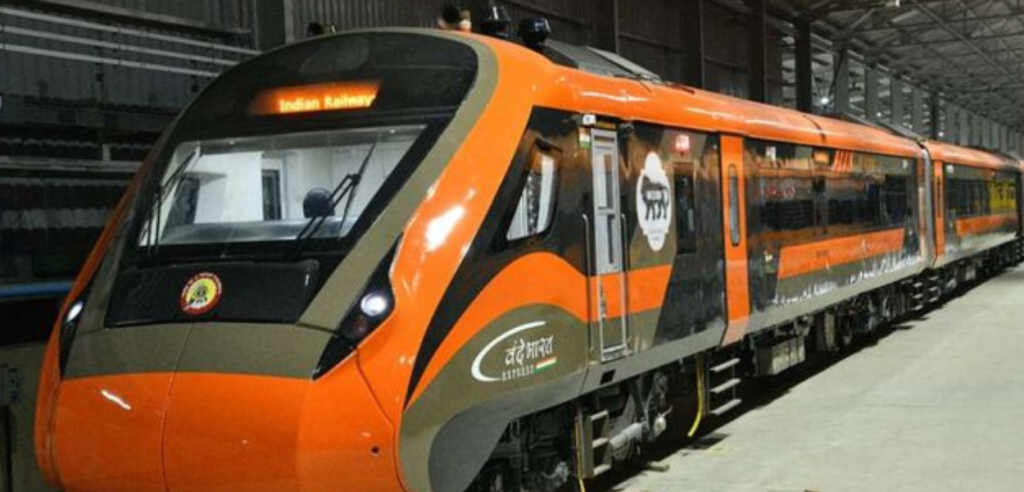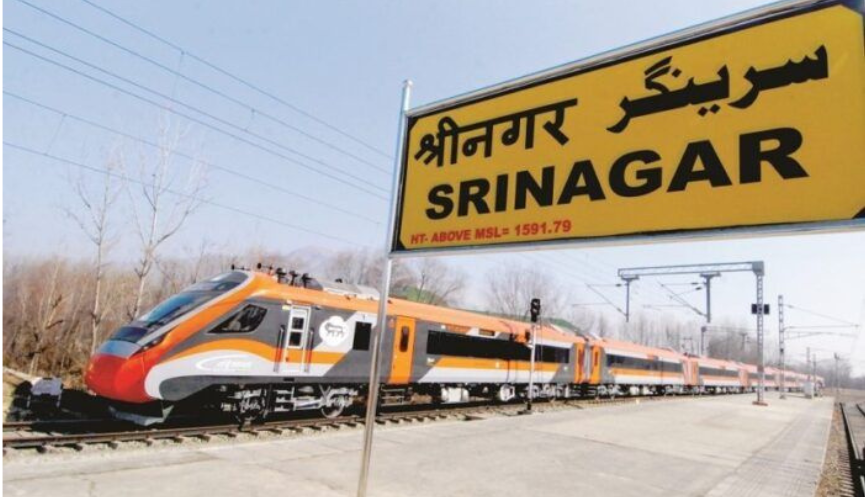
Introduction
Envision a white train passing through rugged valleys and amidst all those green meadows, its whistle echoing off snow-clad peaks and connecting Jammu, Katra, and Srinagar in mere hours of journey. On April 19, 2025, Prime Minister Narendra Modi will flag off the Jammu-Katra-Srinagar Vande Bharat Express, turning all such dreams into reality, the very first semi-high-speed train launched in this region.
This is not merely an architectural marvel but flaunts some political stroke, a bright development beacon, and a connecting bridge to a future that has been long pledged but rarely manifested for Jammu and Kashmir. For a land such as this where it truly has had stories of geographic, political, and emotional isolation, the arrival of trains stirs up shadowy hope in some scepticism.
It is not only about the travel speed but also what those tracks symbolize. With the abrogation of Article 370, the political landscape of Kashmir now looks like a battlefield full of ideologies with the central government claiming to pursue development while local people are demanding autonomy.
The Vande Bharat Express promises to open doors of mobility, tourism, and economic development and thus hangs solidly in that battleground.
Is it going to weave Kashmir closer into the heart of India, or will it yet again be viewed as a top-down imposition? With the train about to roll, the train is already trending in political circles as a new chapter that has to do with steel rails and human aspirations.
The Engineers are curious about The Journey to Kashmir by Vande Bharat
The Vande Bharat Express, India’s homegrown semi-high-speed train, is a technological triumph tailored for Kashmir’s unforgiving landscape. Capable of hitting 160 km/h, it slashes travel time between Jammu, Katra, and Srinagar to under four hours—a stark contrast to the gruelling 6-8 hour road trips plagued by landslides and weather.
With 16 coaches, onboard Wi-Fi, and panoramic windows framing the Pir Panjal range, it’s designed to elevate both comfort and tourism. This isn’t just a train; it’s a lifeline for a region where connectivity has long been a dream deferred.
Bringing this train to Kashmir demanded ingenuity. The route includes the Chenab Bridge—among the world’s highest railway bridges—and tunnels piercing through Himalayan rock, like the 11-km Banihal tunnel.
Construction battled seismic zones, harsh winters, and logistical nightmares, with costs reportedly exceeding ₹12,000 crore for the broader J&K rail expansion. The Vande Bharat’s deployment here builds on decades of railway ambition, from the Udhampur-Srinagar-Baramulla line’s inception to its phased rollout. It’s a testament to India’s engineering prowess and a nod to the “Make in India” ethos, with the train crafted at Chennai’s Integral Coach Factory.
Beyond specs, this train embodies resilience—both human and mechanical. For engineers who toiled in sub-zero temperatures and for policymakers who pushed through red tape, April 19, 2025, marks a victory lap.
Yet, it’s not without hurdles: security along the route remains a concern, given Kashmir’s volatile history. Still, as the train’s sleek silhouette emerges from mountain tunnels, it signals a future where isolation yields to access. It’s a rolling monument to what’s possible when ambition meets adversity—a story Kashmir knows well.
Political Crossroads: The Train as a Power Play
For the Modi administration, the Vande Bharat Express is a gleaming trophy in its Kashmir playbook. Launched on April 19, 2025, it dovetails with the narrative of development post-Article 370’s revocation, a move that stripped J&K of its special status. Union leaders tout it as proof of integration, with Amit Shah recently reaffirming statehood promises—albeit without a deadline.
The train’s route, linking Katra’s Vaishno Devi shrine to Srinagar, doubles as a cultural and electoral bridge, appealing to Hindu pilgrims and BJP voters nationwide. It’s a calculated flex of centralised power in a region wary of it.
Kashmir’s political spectrum crackles with debate over this train. BJP leaders in J&K, like Sunil Sharma, hail it as a catalyst for jobs and stability, aligning with claims of terrorism’s decline since 2019.
Yet, regional parties like the National Conference and PDP see it differently. They argue that infrastructure, however impressive, can’t replace political agency—a fully empowered assembly or restored statehood. For them, the train risks being a shiny distraction from deeper grievances, especially as unemployment and governance woes persist. It’s a tug-of-war between Delhi’s vision and Kashmir’s voice.
Internationally, the launch reverberates too. S. Jaishankar’s recent UN critique of Pakistan’s occupation of Kashmir (March 18, 2025) frames this train as part of India’s assertive stance—development as diplomacy.
Pakistan, meanwhile, watches warily, its border provocations (like the April 1 LoC firing) a reminder of the stakes. The Vande Bharat isn’t just a domestic win; it’s a geopolitical marker. As it speeds through Kashmir, it carries the weight of Delhi’s ambitions, local aspirations, and a fractious history—making it a political lightning rod on rails.

Kashmir’s Lifeline: How the Train Could Change Lives
For Kashmiris, the Vande Bharat Express could be a game-changer. Tourism, battered by decades of conflict, might surge as travelers zip from Jammu to Srinagar, drawn by the valley’s fabled beauty.
Local artisans, hoteliers, and guides stand to gain, with estimates suggesting a 20-30% tourism boost in the first year, per industry analysts. Beyond leisure, the train opens markets—apples from Sopore or saffron from Pampore could reach Delhi faster, bolstering trade. It’s a lifeline for an economy gasping under unemployment and stagnation.
On a human level, the train promises practical relief. Students can access universities in Jammu or Katra without the ordeal of treacherous roads. Patients needing specialized care outside the valley gain a safer, quicker option.
For families split across J&K’s expanse, it’s a chance to reconnect without breaking the bank—though ticket prices, yet to be finalized, will be key. Accessibility matters too; new stations must cater to rural Kashmiris, not just urban hubs. If done right, this could ease the daily grind in a region where mobility has long been a luxury.
Yet, optimism comes with caveats. Security looms large—militancy, though reduced, isn’t extinct, and the train could be a target. Affordability is another hurdle; if fares mirror other Vande Bharat routes (₹1,000-2,000), they might exclude the poorest.
And then there’s the emotional divide: some Kashmiris see it as an outsider’s gift, not a local win, deepening mistrust. Will it unite or alienate? As the first passengers board on April 19, 2025, their stories will shape the answer. For now, it’s a fragile hope—a train that could carry Kashmir toward prosperity or stall at the station of scepticism.
Conclusion
The Jammu-Katra-Srinagar Vande Bharat Express, set to debut on April 19, 2025, is more than a train—it’s a mirror reflecting Kashmir’s past, present, and potential. Its tracks weave through engineering triumphs, political chess moves, and the quiet dreams of a people caught in history’s crosshairs. For the central government, it’s a gleaming emblem of progress, a counterpoint to critics of its Kashmir policy.
For locals, it’s a paradox—offering economic promise yet shadowed by questions of agency and identity. As it speeds across the Chenab Bridge or tunnels through Banihal, it carries a region’s complexities at 160 km/h.
This launch isn’t an endpoint but a beginning. If security holds and fares align with Kashmiri wallets, it could spark a renaissance of tourism and trade, softening the edges of decades-long isolation.
Yet, if it’s perceived as a Delhi-driven vanity project, it risks fueling resentment in a land where trust is scarce. The train’s true test lies not in its horsepower but in its ability to bridge divides—geographic and human. As Kashmir watches those first wheels turn, the world watches too, for this is a story of more than rails; it’s about a region’s place in India’s future.




